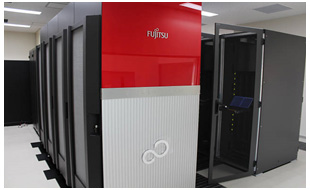Tokyo, March 26, 2014
Fujitsu announced that it has completed building a supercomputer system ordered by the SPring-8 Center, a part of RIKEN, Japan's largest comprehensive research institution.
At the core of the new system is the FUJITSU Supercomputer PRIMEHPC FX10. Due to commence operation in April 2014, it will have a theoretical peak performance of 90.8 teraflops (TFLOPS) (1).
The RIKEN SPring-8 Center currently plans to use the K computer(2) to analyze the enormous volumes of data being generated by the SACLA X-ray free-electron laser(3), with the goal of understanding the structures and functions of nanomaterials.
The PRIMEHPC FX10 will be used to conduct preliminary analysis such as data screening prior to more detailed analysis by the K computer, as well as to develop analytical software in line with the characteristics of experimental data. This deployment is expected to improve the efficiency of data analysis performed with the K computer, thereby dramatically reducing the time needed for structural analyses of nanomaterials. It is also intended to help accelerate the generation of research results in the development of new materials and in the biotechnology field with potential industrial applications.
Background to Deployment of the New Supercomputer System
 PRIMEHPC FX10
PRIMEHPC FX10
SACLA uses the world's shortest-wavelength (0.06 nanometers) high-power X-ray laser beam with a 10-femtosecond (ten one-hundred-trillionths of a second) pulse to observe the ultrafast movements of atoms and molecules. This has revealed a world never seen before, showing the structures and characteristics of materials at the atomic and molecular levels.
SACLA generates enormous volumes of experimental data - as much as 100 terabytes (TB) per experiment - meaning detailed analyses require massive computing power, for which the K computer is expected to be used.
The PRIMEHPC FX10 is being deployed to conduct preliminary analysis before data is analyzed on the K computer. The PRIMEHPC FX10 is compatible with applications that run on the K computer, making it possible to use the PRIMEHPC FX10 for developing analytical software tailored to the experimental data's characteristics, and to conduct data screening for more detailed analysis by the K computer. This will dramatically shorten analysis times for nanomaterial structures. For example, the existing supercomputer system at SACLA took two weeks to perform analysis that classified two-dimensional patterns from over one million images captured by SACLA, but this is expected to take only four hours on the K computer.
Overview of the New Supercomputer System
The PRIMEHPC FX10 further improves on Fujitsu supercomputer technology employed in the K computer, with greater performance, improved scalability, higher reliability, and lower power usage. This PRIMEHPC FX10 system comprises four racks and 384 nodes with a theoretical peak performance of 90.8 TFLOPS. The system uses the Technical Computing Suite as its HPC middleware, and eleven FUJITSU Server PRIMERGY RX300 S8 units for login nodes and other ancillary functions. For storage, the system uses FUJITSU Storage ETERNUS DX80 S2 running FEFS(4) software for high-performance scalable file systems.
Key specifications of the new supercomputing system are as follows.
Composition of the New System
| Computing nodes |
PRIMEHPC FX10 |
| Racks |
4 |
| Computing nodes (CPUs) |
384 (384) |
| Theoretical peak performance |
90.8 TFLOPS |
| Total storage capacity |
12 TB |
| Interconnect |
Tofu (6-dimensional mesh/torus) |
| Login nodes/management servers |
11 PRIMERGY RX300 S8 units |
| Shared storage for management server |
1 ETERNUS JX40 unit |
| Local file system |
13 ETERNUS DX80 S2 units; 100 TB |
| Global file system |
5 ETERNUS DX80 S2 units; 500 TB |
| File system |
FEFS |
Future Prospects
By creating an efficient way for SACLA to work together with the K computer, it should become possible to provide Japanese industry with the world's most advanced research infrastructure. It is anticipated that the system will contribute to innovation in a range of fields, such as with the development of pharmaceuticals and new materials, fuel cells and ultra-large-scale integrated circuits.
With more than 30 years of experience building and supporting high-performance computers, Fujitsu is providing total support to RIKEN's R&D and analysis projects.
Comment from Makina Yabashi, Group Director, RIKEN SPring-8 Center
Following the inauguration of SACLA two years ago, we have been able to run a variety of experiments on SACLA, which combines a state-of-the-art accelerator and optical technologies. The high stability realized at SACLA has contributed to achieving the high hit rates to samples, which produces a much larger volume of data than initially expected. Our biggest challenge at present is quickly analyzing the vast quantities of data being produced every day. The PRIMEHPC FX10 will dramatically shorten analysis times, and by promoting the combined usage of the K computer and SACLA, two of the country's most advanced research platforms, we look forward to bringing about innovations across a wide range of disciplines and industries.
